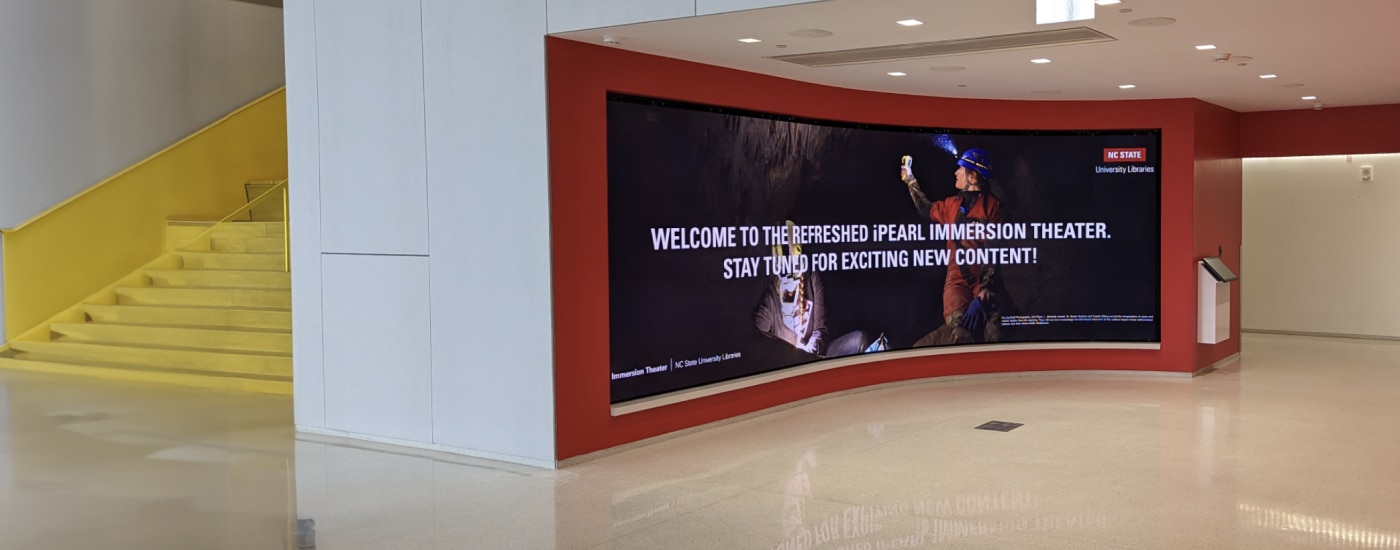
Crystal LED gives visitors an immersive visual experience at North Carolina State University’s James B. Hunt Jr. Library
University library replaces its increasingly unreliable and hard to support video walls with Sony’s Crystal LED large display technology.

- University library required new large display solution to replace its aging video walls

- Crystal LED video wall measuring 6 x 2.4m with 4,000 x 1,620 pixel resolution

- Curved wall gives immersive viewing experience from different angles
- Highly reliable operation
The reception to Crystal LED has been positive, with staff and visitors impressed by the quality and how immersive the images are.
Ryan Hunter
Lead AV Professional for Advanced Technology spaces at North Carolina State University’s Libraries
Video wall technology supports university students and staff
Ryan Hunter is the Lead AV Professional for Advanced Technology spaces at North Carolina State University’s Libraries. He supports several video walls and high-tech areas that serve as large multipurpose rooms or spaces which can be used by faculty, students and staff. Here Ryan discusses NCSU’s decision to install Sony’s Crystal LED video wall technology at the university’s James B. Hunt Jr. Library.

Next-level visuals, dependable operation
Ryan Hunter: “The James B. Hunt Jr. Library serves a big purpose for our students, but it’s also open to the public. When the library was built over ten years ago multiple video walls were installed simultaneously, running virtually non-stop 24/7. Over time they ended up requiring repairs and needing to be replaced. The parts and support we needed were no longer available, and we had to start planning to replace these walls.
“I saw Sony’s Crystal LED video wall in action while attending InfoComm in 2019, and I thought it looked incredible. It was a level beyond what everybody else was able to provide at the time and as far as I’m concerned, it still is. We considered various manufacturers, and when it came down to image quality Sony got the general vote. We were also sold on Crystal LED because of its resolution and the fact that it supports a 120 Hz refresh rate and High Dynamic Range (HDR). Its simplicity is another high point. Being able to expedite that repair time is another huge benefit. In the event of an issue our video wall will not be down for nearly as long as it used to be.
Amazing image quality delivers an immersive experience
“We’ve installed one CLED video wall, in the space known as the iPearl Immersion Theater. Displayed on a curve to give viewers an immersive experience from many different angles, the iPearl Immersion Theater’s video wall is approximately 20 feet by 8 feet with a resolution of 4000 x 1620. It works as a digital exhibit space for student, faculty and community projects, so viewers will see student and faculty work, community project results, and special events such as a “Martin Luther King Experience.” In addition to the amazing image quality, individuals can also experience a virtual reality environment where they’ll watch a speech and the image quality paired with sound effects can make them feel like they’re attending the speech in person.
“Due to its flexible support of digital content creation frameworks and game engines – such as Unity and Unreal – Crystal LED also opens the door for students to come in and build their projects off those templates, which empowers their creativity.
Positive reception
“The reception to Crystal LED has been positive, with staff and visitors impressed by the quality and how immersive the images are. So far we’ve only installed one CLED video wall, but we plan on installing a second one called the ‘Art Wall’. This won’t be used for immersive content or instructional purposes, but it will be a great way to display digital signage and student artwork.
“Sony were great to work with when it came to defining the parameters of what could fit, what would work, and the maximum curve for this wall. Working with the curved shape required careful consideration, as Sony would only recommend certain degrees to make it work flawlessly.”